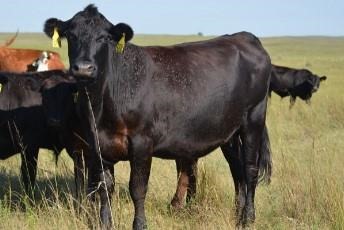By Dave Boxler
With summer grazing season almost here, now is the time to prepare a horn fly management plan. Developing an effective plan requires some knowledge about the fly’s habits, life cycle, economic impact, and available control strategies.

United States livestock producers lose over $1 billion annually to the horn fly, making it one of the most damaging ectoparasites of pastured cattle. Horn fly feeding cause’s dermal irritation, anemia, decreased feed intake leading to reduced weight gains, and diminished milk production. Horn flies have also been implicated in the spread of summer mastitis. Furthermore, an estimated $60 million is spent annually on insecticidal control. Studies conducted in Nebraska have established calf weaning weights were 10-20 pounds higher when horn flies were controlled on mother cows. The horn fly also affects yearling cattle reducing yearling weights by much as 18 percent. The economic injury level (EIL) for horn flies is 200 flies per animal. An economic injury level is when the economic impact of the pest equals treatment costs. During the summer horn fly numbers on untreated Nebraska cattle can exceed several thousand (Figure 1 http://go.unl.edu/22sm).
Horn flies are small in size, approximately 3/16” in length and are usually found on backs, sides, and poll area of cattle. During a warm summer afternoon they can be found on the belly region of cattle. Horn flies, both male and female, acquire more than 30 blood meals per day. After mating the female fly will leave the animal to deposit eggs in fresh cattle manure. Eggs hatch within one week, and larvae feed and mature in the manure, pupating in the soil beneath the manure pat. Newly emerged horn flies can travel several miles searching for a host. The entire life cycle can be completed in 10 to 20 days depending upon the weather.
Many insecticide control methods can manage horn flies; cattle backrubbers (oilers), dust bags, insecticide ear tags and strips, pour-ons, feed-through products, low pressure sprayers, mist blower sprayers, and the VetGun. Backrubbers (oilers) and dust bags can be an effective way to reduce horn fly numbers if cattle are forced to use them. If cattle are not forced to use them expect between 35 – 50 % less control. Insecticide ear tags and strips are a convenient method of horn fly control if applied at the correct time. In Nebraska, ear tags and strips should be applied during the last week of May or the first week in June to achieve maximum control through the fly season. Ear tags and strips applied too early will decrease in efficacy while fly numbers are still high, resulting in economic loss. In addition, adult animals should receive two tags; tagging only the calf will not provide the desired level of control. Animal sprays, mist blower applications, and pour-on products will provide 7 to 21 days of control and need to be re-applied through-out the fly season. Feed-through products, such as oral larvicides and insect growth regulators (IGR’s), prevent fly larvae in manure pats from developing into adults. Steady consumption is necessary when using a feed-through product. Horn fly migration from neighboring untreated herds can mask the effectiveness of a feed-through. The VetGun applies an individual capsule of insecticide to an animal using a device similar to a paint ball gun, and can provide horn fly control for 21 to 35 days.
Many horn fly populations in Nebraska exhibit resistance to synthetic pyrethroid insecticides. To manage resistance be sure to alternate insecticide classes (insecticide ear tags, animal sprays, pour-ons, and feed-through products).
Insecticides have been placed into numbered insecticide Mode of Action (MOA) groups based on how they work against insects. Mode of action groups include organophospahtes (Group 1B), pyrethroids and pyrethrins (Group 3), avermectins and milbemycins (Group 6), juvenile hormone analogues (Group7A), and benzoylureas – chitin inhibitors (Group 15).
Continual use from a single MOA against a species can lead to reduced control (resistance to all products in the group). To improve control, do not apply insecticides within the same group number repeatedly. Rotate between MOA groups during the fly season. A list of delivery methods, labeled insecticides, and their MOA for horn fly control are found in Table 1 (http://go.unl.edu/kzbh).
Source:unl.edu